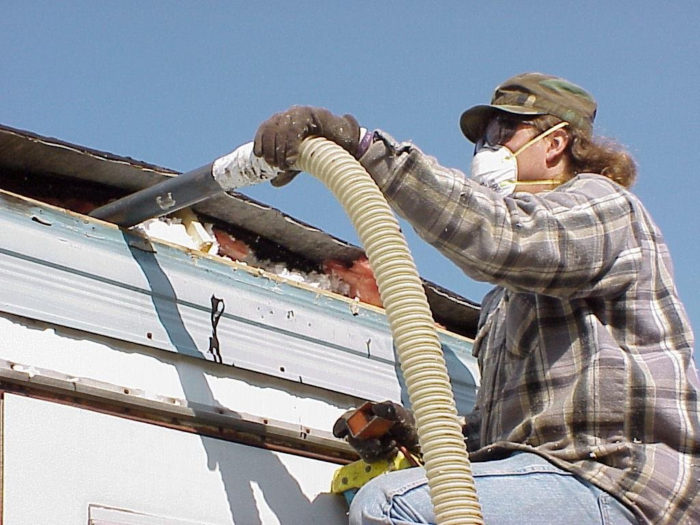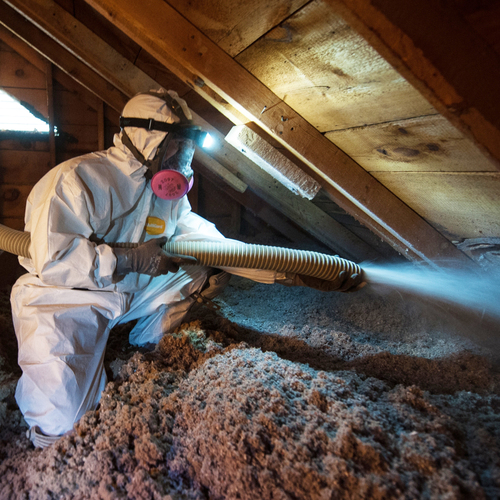
Image Credit: West Virginia Weatherization Assistance Program
$6.2 billion for energy improvements to homes of low-income families
WASHINGTON, DC — The economic stimulus bill passed this week by the U.S. House of Representatives proposes a huge increase in spending for the Weatherization Assistance Program. The House bill includes $6.2 billion in weatherization funding. Since the funds are intended to be spent over three years, the funding would amount to nine times last year’s spending of $227.4 million. All eyes are now focused on the Senate, which is expected to pass its own version of the economic stimulus bill soon.
Since 1976, the US Department of Energy’s Weatherization Assistance Program has provided energy retrofit work for the homes of low-income families at no charge. Such work typically includes air-tightening measures, insulation upgrades, and HVAC system improvements. Every dollar invested in the program yields $1.65 in energy savings for low-income families.
According to BusinessWeek.com, the sudden increase in weatherization funds would be “so large that federal, state, and local agencies are expected to find allocating them and conducting sufficient oversight a real challenge. … Industry insiders (who don’t want to go on record criticizing the package) are doubtful that the new funds will be dispersed in a smart and timely manner — state and local agencies, they say, just can’t ramp up fast enough.”
However, Robert DeSoto, DOE’s weatherization project manager, is confident that the program can handle a sudden influx of funding. DeSoto envisions an increase in the maximum spending per house from $3,055 to $5,000 and an increase in the maximum income level for eligible families.
The BusinessWeek.com article noted that weatherization is “low-hanging fruit for the fight against climate change — the technology is widely available (insulation, more efficient building materials), unlike many forms of clean power generation that are still too expensive or still in the development phase.”
Weekly Newsletter
Get building science and energy efficiency advice, plus special offers, in your inbox.















5 Comments
Why should this be free?
I was talking to a guy last night who has a decent income and lives in a classic "energy sucking McMansion" and wants to do something to cut his power bills but is holding off to see what kind of tax credits might be coming from the new administration.
We are looking at a proposal to give up to $5,000 worth of energy upgrades to two million low-income homeowners. Why shouldn't we instead provide a program that can loan them the money to do the upgrades and re-pay the loan out of the money they save? Giving stuff away for free gives people the idea that it's supposed to be free. What we call cultivating a culture of entitlement.
It's not just low-income people who live in under performing houses either. I know plenty of middle class people with leaky duct work, crawls and attics who are paying lots of money to heat and cool the air around their homes. But many of these folks don't have an extra five grand in their budgets to perform these upgrades even if they may get the money back at tax time. Or they are waiting to see if the government will give them the work for free.
Rather than spend $5,000 per house to give weatherization away, lets invest in the infrastructure to nurture a weatherization industry based on zero down payment loans for most basic energy upgrades with re-payment equivalent to the energy saved. I'm talking about sealing duct work and ceiling planes, upgrading attic insulation, and sealing crawlspaces. Simple stuff done with proper building science based oversight on a massive scale.
We need to provide this opportunity to renters and small businesses as well. How about instead of providing these loans based on income statements and home-equity we just secure them with the electric grid connection? The re-payment would be added to the electric bill and if you don't pay your electric bill your power would get shut off. No need to provide income statement or home appraisal to get this loan, just be current on your light bill. The projects would have to be limited to buildings where the loan payment would be equivalent to the savings in fuel costs so we'd need to mobilize an army of DOE licensed energy auditors to pre-audit the homes to qualify the most promising buildings to work on and verify the quality of the workmanship on completion. So you'd have a zero down payment net zero cost loan program that wouldn't cost the federal budget $5,000 per building so we could address the problems in many more buildings and more quickly reduce our dependence on foreign oil while putting lots of Americans back to work.
We need to create a culture of personal responsibility, we're not going to get there through a program of $5,000 hand-outs and we're not going to fix our energy dependence problem by just fixing two million buildings, we need to aim to fix seventy-five million homes and light commercial buildings. We can do this if we approach it through building a weatherization industry rather than just focusing on fixing houses.
Don't criticize the program yet
Michael,
I think we should hold off our criticism of Obama's weatherization programs until they take shape. So far, no one can be sure who will be eligible, how much will be spent on the average house, and whether or not homeowners will need to contribute.
Personally, I think that the existing low-income weatherization program has tremendously benefited the country, by targeting aid to those least able to afford high energy bills, and providing employment to weatherization workers, and reducing (however slightly) our dependence on imported oil.
Far more open to criticism, in my opinion, are most existing subsidies for photovoltaic systems. The vast majority of the beneficiaries of PV subsidies are middle-class or upper-class Americans, not low-income Americans. And the return on the public investment in PV systems is a pittance compared to the return on investment for weatherization work.
It's precisely the return on investment that I'm aiming at
Martin,
I'm not taking aim at Obama's programs specifically, I'm just hoping to point out that the problem is very wide spread and needs a systems approach that addresses the needs of renters and light commercial as well as the middle class and McMansion dwellers without relying on give-aways. Tax credits are give-aways just as much as no-cost weatherization programs.
I just want to point out that if we finance it right and get good building science involved there are a lot of buildings in America where the savings would equal the loan payment on the weatherization especially as the cost of fuel inevitably goes up. If we can seek these opportunities out should we subsidize a project that has the potential to pay for itself?
I'm just saying that we need to be responsible with the tax dollars, especially when we are talking about deficit spending as opposed to pay as you go. Lets do all we can to reduce our nations dependence on fossil fuels while at the same time minimizing the amount of money we borrow from our grandchildren and putting as many of our neighbors to work in a new green economy as we can.
I agree with you that the tax subsidies for PV have been a bad investment for the country compared to home weatherization programs. I refer to them as "tax farming" with my customers and always encourage envelope improvements over alternative energy though we do install solar water heating on almost every house we build. I'd rather invest tax dollars in R&D than putting panels on roofs directly. But the tax credits do encourage real world innovation. (seen how Velux pipes their panels to their heat exchangers?)
So it's a mixed bag but I think some innovation in the way people finance energy upgrades on existing buildings could lead to a lot more homes being weatherized than just giving money to homeowners to make energy improvements that save them money.
Market transformation
Having been involved in home performance at varying levels for a while, I have come to the conclusion that the biggest problem is the initial cost of the work and the ability and willingness of homeowners to invest for a long term return. If homeowners could borrow the money for home performance improvement on the same terms as their mortgage (30 years at +/=5%) they would probably find it to be in excellent investment and jump right on it. Unfortunately, the only way to get money at this rate is to roll it into the first mortgage at the time of purchase. Since most real estate agents are unlikely to recommend energy audits that would suggest additional work at increased costs, unless a purchaser was aware of the options, chances are they will not investigate energy upgrades until they have purchased and moved into the house. Faced with coming up with thousands of dollars for these improvements out of their own pockets, most people will avoid a single, large, long term investment, settling instead for small payments through higher energy bills and personal discomfort. The first order of business is to encourage energy audits and improvements at the time of purchase. Could we require or create incentives for this to happen? Another alternative is to provide financing equivalent to first mortgages to interested homeowners. A third option is to have the work paid for by power companies who could then recoup the expenses through the difference in the energy bill - while energy use would go down, the homeowners would continue to pay the same as their higher pre-improvement bill, and the utility would make their money back for the life of the house - likely an excellent long term investment for them. All of these are viable, they just need a combination of will and regulations to make them happen.
Weatherization
I was recently approved for the weatherization program because of my income, and being disabled. Am I supposed to accordiing to Michael, Pay a higher power bill. Or loan to have a warmer house to live in? My power bill now is over a 150.00 a month. I can barely pay this bill now. I'm very thankful for programs like this. That help low income famlies make their homes more energy efficient. Try living off of SSI, pay your bills and do home improvements. Programs like this is a God send for poor people like me.
Log in or create an account to post a comment.
Sign up Log in